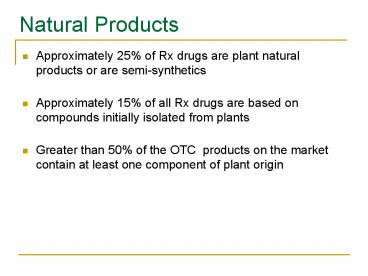Natural Products - PowerPoint PPT Presentation
1 / 38
Title:
Natural Products
Description:
Approximately 15% of all Rx drugs are based on compounds ... Atropine: isolated from Atropa Belladonna. Anticholenergic agents. Common plant-derived drugs ... – PowerPoint PPT presentation
Number of Views:4060
Avg rating:3.0/5.0
Title: Natural Products
1
Natural Products
- Approximately 25 of Rx drugs are plant natural
products or are semi-synthetics - Approximately 15 of all Rx drugs are based on
compounds initially isolated from plants - Greater than 50 of the OTC products on the
marketcontain at least one component of plant
origin
2
Common plant-derived drugs
- Morphine isolated from Papaver somniferum
- Narcotic Analgesic
3
Common plant-derived drugs
- Quinine isolated from Cinchona officialis.
- Antimalarial
4
Common plant-derived drugs
- Vinblastine isolated from Cantharanthus roseus
- Anticancer
5
Common plant-derived drugs
- Atropine isolated from Atropa Belladonna
- Anticholenergic agents
6
Common plant-derived drugs
- Digitoxin from Digitalis purpurea (foxglove)
- Cardiac glycoside CHF
7
Common plant-derived drugs
- Taxol isolated from Taxus (Pacific Yew)
- Anti-cancer
8
Common plant-derived drugs
- Etoposide isolated from Podophyllum Peltatum
- Anti-cancer
9
Common plant-derived drugs
- Colchicine isolated from Colchicum Autamnale
- Gout
10
Common plant-derived drugs
- Acetyl Salicylic Acid isolated from Salix Alba
- Analgesic
11
Natural Products Chemistry
- Primary metabolites1. Direct function in
primary biochemical pathways - ? are essential for life (G-3P, R-5P)
- Secondary metabolites1. Synthesized directly
from primary metabolites2. NOT involved in the
primary life-sustaining processes - ? important in proper biochemistry
12
Secondary Metabolites
- Primary classes
- Terpenes Cholesterol synthesis
- Phenylpropanoids Fatty acids
- Polyketides Fatty acids
- Steroids Progesterone, etc.
- Glycosides Protein glycolosys, etc.
- Alkaloids Amine containing moiety
13
Terpenes
- Common examples and plant parts
- Cinnamon in bark
- Peppermint in hairs on leaves
- Lemon - in the rind
- Rose in the petals
- Ginger in the rhizome
14
Terpene Synthesis
- Synthesized by the mevalonic acid pathway
15
Terpene Synthesis cont.
16
IPP and DMAP Biological Isoprene Building
blocks
C10 Geranyl isoprenoid synthesis
17
IPP and GPP Biological Isoprene Building
blocks
C15 Farnesyl isoprenoid synthesis
18
FPP Biological Isoprene Building blocks
C30 Squalene synthesis
19
Mevalonic Acid Pathway Produces Cholesterol
20
Mevalonic Acid Pathway Produces Cholesterol
21
Terpene Classes
- C5 Hemiterpenes
- C10 Monoterpenes
- C15 Sesquiterpenes
- C20 Diterpenes
- C25 Sesterterpenes
- C30 Triterpenes
- C40 Carotenoids
22
Examples of Terpenes
23
Phenylpropanoids
- Occur as mixtures with Terpenes in essential oils
isolated from plants - Flavonoids water soluble plant pigments
- Anthocyanidins improve microcirculation
nightvision - Coumarins - Anticoagulants
- Lignans Anti-cancer drugs
- Tannins in green tea, red raspberry witch
hazel - Interact with Theophylline/Aminophylline
(bronchodilators)
24
Phenylpropanoid synthesis
Shikimic Acid Pathway
25
Shikimic Acid Pathway
26
Shikimic Acid Pathway
27
Shikimic Acid Pathway
28
Shikimic Acid Pathway
29
Shikimic Acid Natural Products
30
Shikimic Acid Flavones
31
Shikimic Acid Coumarin Products
32
Shikimic Acid Lignins
A synthetic Lignan
33
Shikimic Acid Tanins
34
Polyketide Biosynthesis
Highly modified via cyclization, reduction and
oxidation
35
Glycosides Aglycone plus a Sugar
An Aglycone is the non-sugar compound that
remains after replacement of a glycosyl group in
a glycoside
36
Alkaloids
- All contain at least one nitrogen atom
- Names often end in ine, Large complex
structures
37
Alkaloids - Examples
- All contain at least one nitrogen atom
- Names often end in ine, Large complex
structures
38
What should I remember?
- Many drugs are derived from plants
- Primary v. Secondary metabolites
- Key secondary metabolites
- Terpenes
- Phenylpropanoids
- Polyketides
- Steroids
- Glycosides
- Alkaloids
- Reactions that they undergo
- Mevalonic acid pathway
- Shikimic acid pathway
- Products that are formed
- Endogenous (i.e. steroid hormones, etc.)
- Exogenous (drugs)































